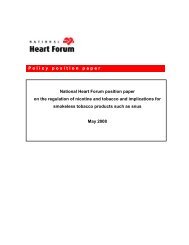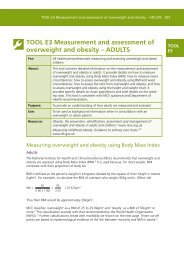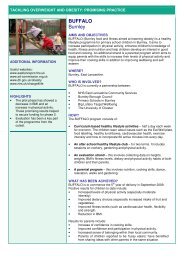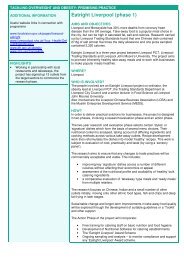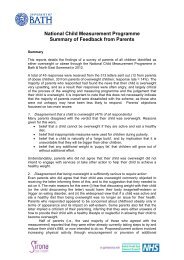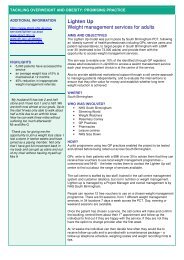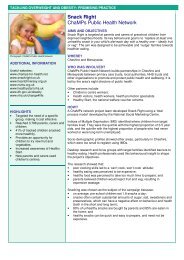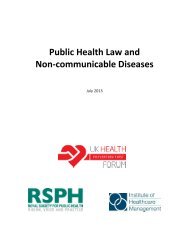The Challenge of Non-Communicable Diseases and Road Traffic ...
The Challenge of Non-Communicable Diseases and Road Traffic ...
The Challenge of Non-Communicable Diseases and Road Traffic ...
Create successful ePaper yourself
Turn your PDF publications into a flip-book with our unique Google optimized e-Paper software.
64 <strong>The</strong> <strong>Challenge</strong> <strong>of</strong> <strong>Non</strong>-communicable <strong>Diseases</strong> <strong>and</strong> <strong>Road</strong> <strong>Traffic</strong> Injuries in Sub-Saharan Africa<br />
BOX 13: Supporting PLWH Self-Management Leads to Exp<strong>and</strong>ed Services in Tanzania<br />
In the Morogoro Region <strong>of</strong> Tanzania, the USAID Health Care Improvement project has been working with providers, health<br />
<strong>of</strong>ficials, <strong>and</strong> community-based organization to support a facility-based, peer mentoring program for people with HIV.<br />
PLWH with a record <strong>of</strong> successful self-management are recruited <strong>and</strong> trained as expert patients, known as “peer mentors”.<br />
<strong>The</strong>y volunteer at health facilities to support new HIV patients <strong>and</strong> patients having difficulties in providing good<br />
self-care through group education sessions <strong>and</strong> individual motivational counseling. Improved self-management support<br />
has resulted in significant increases in adherence, appointment-keeping, <strong>and</strong> the percentage <strong>of</strong> patients expressing the<br />
confidence to self-manage themselves. <strong>The</strong>se peer mentors have also assumed many routine clinic tasks, such as: patient<br />
registration, filing, packaging <strong>of</strong> cotrimoxazole tablets, <strong>and</strong> assessment <strong>of</strong> patients’ nutritional status. Consequent<br />
reductions in provider work load have allowed facilities to begin introducing exp<strong>and</strong>ed services for HIV patients such as<br />
hypertension screening <strong>and</strong> treatment.<br />
Source: [422]<br />
Human Resources for Health<br />
Africa has long struggled with acute health workforce<br />
shortages: SAA has 24 percent <strong>of</strong> the global<br />
burden <strong>of</strong> disease but only 3 percent <strong>of</strong> all health<br />
workers, <strong>and</strong> migration <strong>of</strong> health workers, both to<br />
positions that do not include patient care <strong>and</strong> to<br />
clinical positions in higher income countries, is a<br />
significant problem [442]. Furthermore, some see<br />
the growing private health care sector in some countries<br />
as having the potential to siphon <strong>of</strong>f both human<br />
<strong>and</strong> financial resources [398]. <strong>The</strong> average physician-to-population<br />
ratio in SSA is 2.2 per 10,000<br />
<strong>of</strong> the population (ranging from 0.1 in Liberia to 5.7<br />
in Cape Verde). <strong>The</strong> nursing <strong>and</strong> midwifery personnel-to-population<br />
ratio is nine per 10,000 population<br />
(ranging from 0.4 in Guinea to 28.4 in Botswana)<br />
[397]. <strong>The</strong>re are relatively few specialist training institutions<br />
in Africa, with some countries completely<br />
reliant on foreign education for specialists.<br />
<strong>The</strong> severe shortage <strong>and</strong> imbalanced distribution<br />
<strong>of</strong> trained health workers (<strong>and</strong> health promoters)<br />
is not just an obstacle to tackling NCDs but also to<br />
the delivery <strong>of</strong> good quality clinical services in general,<br />
jeopardizing achievement <strong>of</strong> the MDGs <strong>and</strong><br />
improvement <strong>of</strong> the overall health <strong>of</strong> the poor, suggesting<br />
the need to align health sector, civil service,<br />
<strong>and</strong> macroeconomic policies in finding workforce<br />
solutions [443].<br />
Simply scaling up the production <strong>of</strong> health workers<br />
is not a good enough fix, as urban unemployment,<br />
rural shortages, health sector attrition, including migration<br />
abroad, as well as absenteeism <strong>and</strong> low productivity<br />
(labor market leakages <strong>and</strong> inefficiencies)<br />
will waste investments. Potential solutions need to<br />
identify <strong>and</strong> address country-specific labor market<br />
leakages <strong>and</strong> inefficiencies, including through: (1)<br />
monetary <strong>and</strong> non-monetary incentives; (2) innovative<br />
education models (including rural pipeline<br />
models); (3) increasing opportunities for funding<br />
for human resources for health, particularly in rural<br />
areas; <strong>and</strong> (4) strengthening management <strong>and</strong> accountability<br />
systems in frontline facilities [444].<br />
Task Shifting<br />
Innovative strategies to exp<strong>and</strong> health-system capacity<br />
to address HIV <strong>and</strong> other health challenges<br />
include ‘task-shifting’ in clinical settings so that tasks<br />
performed by physicians (or any higher cadre) are<br />
delegated where appropriate to lower cadre health<br />
workers who have a defined set <strong>of</strong> skills or been specifically<br />
trained to perform a limited task [445]. Appropriately<br />
trained nurses have been demonstrated<br />
to provide effective care for patients similar to that<br />
provided by doctors, <strong>and</strong> to achieve positive health<br />
outcomes in chronic disease management, illness<br />
prevention, <strong>and</strong> health promotion [446-447]. This<br />
approach has been applied in a range <strong>of</strong> NCDs, such<br />
as asthma, hypertension, <strong>and</strong> diabetes mellitus, <strong>and</strong><br />
with minimal additional resources can also improve<br />
patient retention <strong>and</strong> satisfaction for chronic disease<br />
management [448-453].<br />
While the rationale behind transferring the tasks is<br />
that the alternative would be no service at all to those<br />
in need, the approach is not without risk. Unless<br />
planned <strong>and</strong> managed appropriately, there is potential<br />
for fragmentation <strong>and</strong> decreased quality <strong>of</strong> care, <strong>and</strong>



